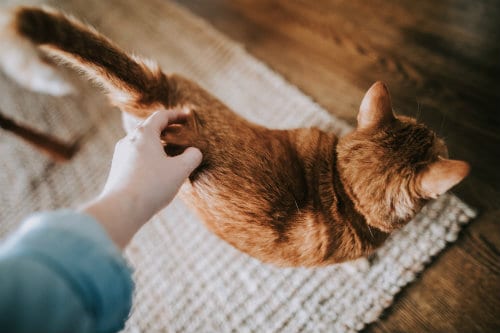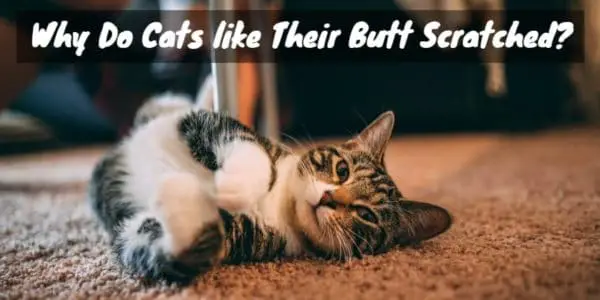When your cat cuddles up to you for some quality petting time, you may find yourself constantly scratching just at the base of their tail. This is basically because a concentration of nerve endings make your cat’s butt the best place for them to get maximum pet-age for their efforts. The sensation of being scratched or petting stimulates the nerve endings and helps your cat feel happy and relaxed!
Cats are extremely sensitive creatures, and have a way more specialized nervous system than humans do. For this reason, if you continue to pet your cat without paying attention to his or her moods, you may find your cat quickly growing overstimulated. No matter where you’re petting your cat, make sure you look for signs that they’re no longer having as much fun as you are.
How Does It Work?

For most animals, touch is an important part of social bonding. Even as humans, we need the constant touch and validation of family members when we’re babies, and most animals exhibit the same needs. Even if cats aren’t herd animals like dogs, they still enjoy that physical reassurance of affection to feel safe and happy.
In most mammals, a special set of neurons lie just below the skin to interpret touches and relay signals back to the brain. The long, repetitive motion associated with petting an animal–or playing with a friend or loved one’s hair–triggers these neurons, and the brain interprets the signal as pleasure or a reward. While these neurons were officially found in mice, they are present in most mammals, no matter the size or scale.
[amazon bestseller=”cat brush”]
As a result, most animals love to be petted. The soothing motion of petting a cat is relayed to the cat’s brain as stimulation of those “petting neurons”, and the brain gets a jolt of enjoyment out of the sensation.
Cats, especially, have a very highly developed nervous systems. Humans have around 5 million nerve endings in their system, while cats have around 19 million. Moreover, these nerve endings are located pretty much over their entire body, as opposed to being concentrated in their paws or extremities.
This explains why cats love being petted so much, but the good news is that you get just as much out of the deal as your cat does! According to The New York Times, prolonged contact with cats can have the same effect on your brain as prolonged contact with humans. Your brain triggers the release of oxytocin and reduces the amount of stress hormones in your blood, so that you feel calm and relaxed.
Your heart rate and blood pressure are generally lower if you spend a lot of time petting your cats, and the long-term health benefits are nothing to sneeze at. Studies show that cat owners are less likely to develop anxiety-related illnesses, and may even be less at risk for heart conditions!
In other words, petting your cat is a great way to kill two birds with one stone. Your cat gets to appreciate the tactile sensations of being petted, and you get to play with your cat! More than that, however, you also get a chance to relax and lower your risk of stress and stress-related medical conditions that could otherwise pose a very real threat to your health.
Okay, but Why the Butt?

The basic rule of thumb when petting cats is that they like to be petted in areas that are difficult for them to reach on their own. This is why areas like the back of the head or beneath the chin are generally preferred. In contrast, petting a place that a cat can groom or scratch on its own is less likely to be as welcome.
[amazon bestseller=”cat scratch”]
In that light, it may seem odd that cats like the butt scratching so much. After all, they seem able to reach the base of their tail for grooming purposes, so it may seem counter-intuitive that they seem to enjoy being petted there.
You may notice, as you pet your cat, that your cat’s back arches and they push up into your hand. Their tail may rise as well, especially if they are already in a standing position. Both adjustments to position reflect their enjoyment of being petted, and serve as the cat’s way of encouraging you to continue.
Some have theorized that cats have an above average concentration of nerve endings around the base of the tail. If this is true, then it would certainly explain why cats so enjoy being petted, as the increased pleasure and contentment signals to their brain would provide a powerful dose of oxytocin or dopamine. These are the two hormones most responsible for happiness in a mammal’s brain, and can show that your cat is relaxed and feeling good.
Others have pointed out that petting near the base of the tail performs a similar sensory role as grooming of kittens by a mother cat. In this sense, petting your cat’s butt lets them act like a kitten again, complete with the relaxed and back-arched behavior that is typically common in younger animals.
No matter the exact reason, the overall reasoning seems to be that cats just really like the way it feels. Most likely, this is due to the higher concentration of sensory neurons and the pleasurable sensations associated with being petted. The regression to younger behaviors may just be a sign of how relaxed and comfortable your cats really are around you and the rest of your family.
[amazon bestseller=”cat tree”]
When Enough Is Enough
As always, it’s important to pay attention to your cat’s body language when you’re petting them. Too much petting can quickly cross the line between pleasant and unbearable, and your cat may quickly tire of being handled. Once they’ve had enough, they can lash out “with no warning”, so that beginning cat owners are often caught off guard by the sudden changes in their pets’ moods.

As mentioned above, the concentration of nerve endings in a cat’s skin, especially around the base of the tail, means that the sensation of being petted can be very intense. While this is usually pleasurable, some pet researchers have compared the sensation of being petted for cats to that of being tickled or lightly scratched in humans. What starts out as a light touch can quickly become something extremely unpleasant or even painful.
Each cat has different limits for how much petting is too much. As you cuddle with your cat, keep an eye out for signs of irritation or discomfort. These could include a twitching tail or a tail that’s lashing back and forth, as if your cat is preparing to pounce.
Purring can also be a pretty good indicator of your cat’s mood. More specifically, if your cat has been purring while you pet them, but they suddenly go silent or start making other, less pleased noises, you should probably think about stopping. This sudden switch in moods can often be a key indication that your cat is no longer enjoying the attention.
For whatever reason, petting around the base of the tail seems far more likely to induce over-stimulation than other areas. Again, this is most likely because cats are more sensitive in that area, and therefore the change from pleasant to painful can happen extremely quickly.
If your cat is acting irritated, stop petting them immediately. Give the cat time to calm down will let their brain stop firing off so many conflicting signals, and can let them relax from the constant sensory overload. They may come back seeking more attention in a few minutes, but paying attention to the warning signs can save you from having to deal with a sore hand or scratched arm.
One of the most common complaints against cats is that they bite or scratch apparently without warning, and some cats have even been removed from otherwise good homes for this reason. Obviously, understanding why cats do what they do is an important part of making sure that they have a good home that can care for them for a long time.
[amazon bestseller=”cat comb”]
Conclusion

Depending on your cat’s individual preferences, he or she may have a specific spot where they love being scratched more than anything else. For some cats, it’s under the chin; for other cats, it’s behind the ears. For a lot of cats, however, the best place to receive any sort of attention is just above the base of the tail.
Petting a cat can be therapeutic for everybody involved, but make sure you’re paying attention to your cat’s mood! Because the sensations produced by scratching the same patch of skin can quickly grow to be too much, absent-minded petting can be a quick way to receive a warning bite or scratch as thanks for your attentions!
For the most part, cats love to be petted as much as we love to pet them. So now, armed with your knowledge of just what your cat is feeling, get ready to give them all the love and attention that they deserve whenever you get a chance!
"In ancient times cats were worshipped as gods; they have not forgotten this."
-- Terry Pratchett






Hi Charles;
What do you recommend doing for two cats (brother and sister) that no longer get along. We adopted them together, when they were kittens, but after a few years we moved to another home and we had to temporarily separate them; we were rehabbing our new home and had to stay at a hotel for a couple of months. When we finally moved into our new home, we reunited them and discovered that they no longer got along. The brother started picking on his sister who in turn started spraying and pooping around the house. Now I take turns confining them and the spraying and pooping has stopped. They are 12 years old now. I have used Feliway, all kinds of herbal relaxants, and even taken them to a behaviorist who put them on Fluoxetine; they never took to that drug because of its taste as I mixed it with their wet food. Any suggestions???